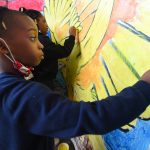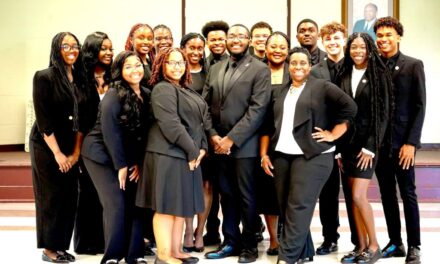By Ryan Michaels
The Birmingham Times
Dozens of students from several elementary and middle schools gathered Friday on a bright and warm morning under the shade of a bridge in downtown Birmingham at the Imagination Festival, which kicked off this year’s Magic City Art Connection at Sloss Furnaces.
Along with the city students were teaching artists who held several workshops that included watercolors, portraits, sculptures, mural art and poetry.
One of the featured artists was Birmingham’s Tania Russell, 26 who taught about the art of choreopoetry, which involves performing written poetry and combining it with body movements.
Choreopoetry — Russell’s chosen form of expression — is a term coined by renowned feminist playwright and poet Ntozake Shange in describing her theatre piece “For Colored Girls Who Have Considered Suicide / When the Rainbow Is Enuf.”
Choreopoetry is a fresh take on the written form, which can interest new people, Russell said.
“You can write for the page, you can write to perform, like a spoken word artist, or you can combine poetry and music, and I felt like that was a good way to get people engaged and to really see how art can be reflective of modern times,” she said.
Most people’s exposure to poetry isn’t relatable, especially because the performance aspect is often so underemphasized, Russell said.
“[When] some people think about poetry, and they think about the old, dead people you see in your English class, but poetry is living. It’s something that has always been like truly endless…poetry was always meant to be spoken and to be performed,” she said.
During her workshop, Russell had students write short poems of affirmation, generally starting with “I am,” followed by positive words the kids wrote about themselves, such as “intelligent,” “African American,” and in one case, “superhero.”
To get the students comfortable, she had them run around in a big circle, and individual students would twirl into the center, say something positive about themselves and twirl back into the mass.
Russell said choreopoetry offers “full engagement” for those doing it. The words of poetry require so much of a person, itself.
“You have to have the self-awareness to be in tune with self to even engage in poetry. You have to have that brutal honesty with self, and not only self. Like, ‘Okay, so I’m struggling, or I’m feeling this negative energy around this. How can I how can I be honest about that? and how can I convert that energy into something positive?’” Russell said.
The motions of this kind of poetry also bring a further awareness, she said.
“It’s inviting other people, it’s inviting you to engage your emotions, and within that, using your emotions intentionally, and that develops a different type of emotional awareness,” the artist said.
And that type of emotional knowledge, not often found in textbooks, is something that kids can get in addition to school, Russell said.
“A lot of the time, with students in general, they’re taught to be book smart. They’re not taught to be emotionally intelligent, so what you get is a lot of very intelligent kids coming up, going out into the workforce, but they don’t know how to handle conflict,” Russell said.
The Imagination Fest featured other artists who shared their versions of self-expression including muralist Dewon Moton, portrait painter Rosa Delgado and ceramist Melissa Noble.
Moton, who worked as a tattoo artist for 14 years before he started painting murals, now has had his work plastered all over Birmingham, like his tribute to Civil Rights leader John Lewis on the side of Gus’s Hot Dogs on 4th Avenue North, or his recent painting of the city on the walls of Upside-Down Plaza bar in Five Points South.
Moton helped students paint their own large-scale image on three large slabs of concrete placed together like an open, trifold presentation board.
Painting murals enables him to reach more people, Moton said. “It opened a doorway to be able to reach a bigger amount of people at one time and also pull people together…People don’t know me personally, but passing by this image, I can convey a message to make you feel [something], so I think that in itself is timeless,” Moton said.
Moton, 30, who grew up partly in Birmingham, said murals can give children hope.
“[Growing up here,] we didn’t get to see much artwork. We saw graffiti, but we didn’t get to see it at its full potential and being able to pull people together, I feel like that’s going to be cool for the kids,” Moton said.
At Delgado’s station, the students drew and painted life-size self-portraits on 3 by 5-foot sheets of vinyl. Each student would stand against the vinyl, while another would trace around their body. After the tracing was complete, students would draw things they like in and outside their body and fill in with paint.
In Delgado’s own work, she conveys feelings through visual elements like backdrops behind subjects. The visually expressive nature of the portraits she had the students complete can be useful, said Delgado, who works with Alaquest Collaborative for Education, a nonprofit which seeks to foster social-emotional learning in children.
“It’s really hard to express how you’re feeling through words, especially when you’re young, so I think, for me, it was like a way to express myself, and I think it’s important to teach them there are other ways to let your feelings out or like express yourself in other ways,” Delgado said.
Noble, who led students in a clay sculpting exercise, focused on the idea of “the made-up thing” at her station. The idea comes from contemporary ceramic sculptor Annabeth Rosen, and Noble used the concept to have students make objects that don’t exist.
“Kids probably have the best imaginations of anyone because as you grow up, we get told, ‘No, you can’t think that way,’ so I think it’s really important to really foster that imagination as young people so that they can grow up and become artists with great art. Even if it’s not their profession, that’s always something good to have,” Noble said.











